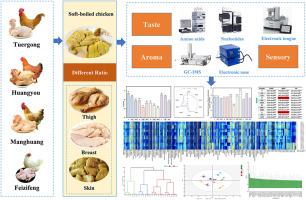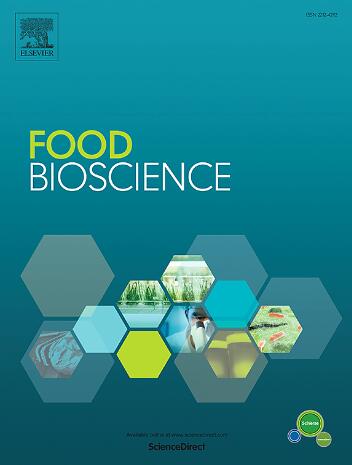Skin-to-meat ratio optimization in soft-boiled chicken: Decoding the dual role of chicken skin in flavor enhancement and umami masking via multi-modal sensory analysis
IF 5.9
1区 农林科学
Q1 FOOD SCIENCE & TECHNOLOGY
引用次数: 0
Abstract
Soft-boiled chicken (Baiqieji) was a traditional delicacy of the Chinese cuisine, characterized by slimy skin and tender meat, bouncy skin and smooth meat. This study investigated the flavor-modulating effects of chicken skin ratios (0 %, 20 %, 33.3 %) in soft-boiled chicken made of different breeds using GC-IMS, electronic sensors, and partial least squares discriminant analysis (PLS-DA). Results showed that skin incorporation significantly altered flavor profiles, with 20 % skin ratio demonstrating optimal enhancement: it increased umami-sweet amino acids, resulting in a 15.12 % improvement in overall sensory scores, while reducing nucleotides (p < 0.05), particularly in Mahuang chicken. Volatile analysis revealed skin-dependent increased in key aldehydes (24.32 %) and esters (20.15 %), correlating with improved aroma. PLS-DA identified 48 key discriminative compounds (VIP>1), including pentyl 3-methylbutanoate, butyl propanoate, 4,5-Dihydro-3(2H)-thiophenone, 3-methylphenol, propylsulfide, as critical flavor markers. These findings pioneer a skin-ratio optimization strategy for low-value poultry breeds, enabling cost-effective flavor enhancement in traditional meat products.

嫩煮鸡皮肉比优化:通过多模态感官分析解读鸡皮增味和掩盖鲜味的双重作用
白鸡是中国传统美食,其特点是皮滑肉嫩,皮有弹性,肉光滑。采用气相色谱- ims、电子传感器和偏最小二乘判别分析(PLS-DA)研究了不同鸡皮比例(0%、20%、33.3%)对不同品种半熟鸡肉风味的调节作用。结果表明,皮肤掺入显著改变了风味特征,20%的皮肤比例表现出最佳的增强效果:它增加了鲜味甜味氨基酸,导致整体感官评分提高15.12%,同时减少了核苷酸(p < 0.05),特别是在麻黄鸡中。挥发性分析显示,关键醛(24.32%)和酯(20.15%)的皮肤依赖性增加,与改善的香气相关。PLS-DA鉴定出48个关键鉴别化合物(VIP>1),包括3-甲基丁酸戊酯、丙酸丁酯、4,5-二氢-3(2H)-噻吩酮、3-甲基苯酚、丙硫醚等作为关键风味标记物。这些发现开创了低价值家禽品种的皮比优化策略,使传统肉制品的成本效益增强。
本文章由计算机程序翻译,如有差异,请以英文原文为准。
求助全文
约1分钟内获得全文
求助全文
来源期刊

Food Bioscience
Biochemistry, Genetics and Molecular Biology-Biochemistry
CiteScore
6.40
自引率
5.80%
发文量
671
审稿时长
27 days
期刊介绍:
Food Bioscience is a peer-reviewed journal that aims to provide a forum for recent developments in the field of bio-related food research. The journal focuses on both fundamental and applied research worldwide, with special attention to ethnic and cultural aspects of food bioresearch.
 求助内容:
求助内容: 应助结果提醒方式:
应助结果提醒方式:


